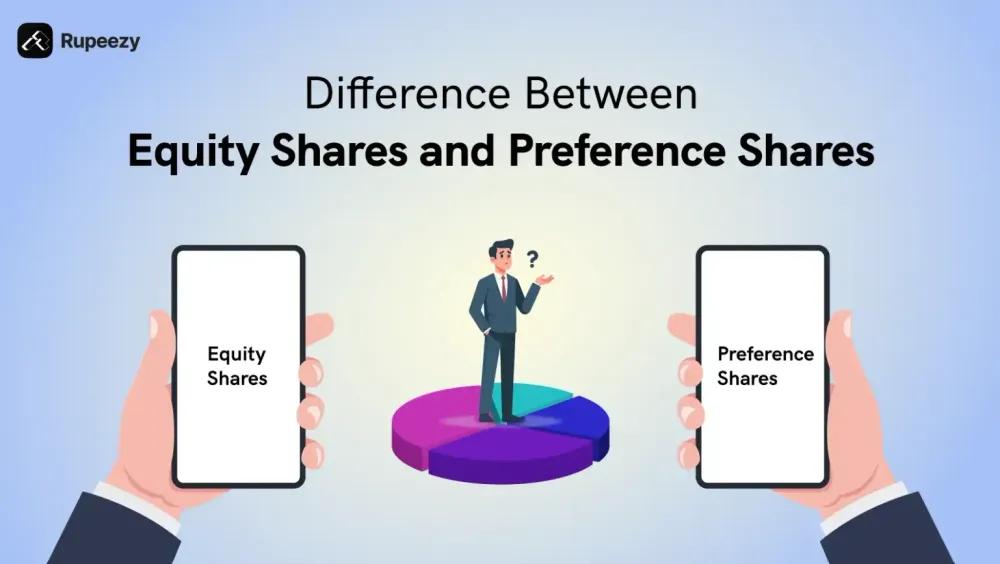Difference Between Equity Shares and Preference Shares


00:00 / 00:00
Let's consider a simple example. Say, X and Y visit a market. X buys a standard product. He gets a higher bonus based on company performance. Y chooses a premium package. He pays extra for guaranteed bonuses and priority to ensure a smoother, more predictable experience. Both get the product, but Y enjoys assured benefits.
This mirrors the basic difference between equity shares and preference shares. But the question that arises here is which one you should choose. Well, to get an answer to this, you first must understand what these two are and their difference. So let’s get started!
What are Equity Shares?
Equity shares are also known as ordinary or common shares. These represent a fundamental form of ownership in a company. When a company needs long-term financing, these shares are issued to various types of investors through various allotment methods
By allotting these shares, the company gives investors a stake in its ownership and growth. Hence, equity share represents a unit of that ownership. The funds raised from selling these shares help the company meet its financial needs.
Here are the key features of equity shares:
Ownership Stake: Equity shares signify ownership in a company, making shareholders partial owners with a stake proportionate to the number of shares held by them.
Voting Rights: Shareholders have the right to vote on certain company decisions. They have the power to participate in crucial events which can shape the future of the company.
Dividend Income: Equity shareholders get dividends. This is a part of the profit they offer and is decided by the board of directors. This is a bonus for their investment in the company.
Capital Gains: If a company is listed on any exchange, it is prone to price fluctuations. So, when the shareholders can benefit from selling the shares at a higher price than they bought and earn profits.
Limited Liability: Shareholders' financial liability is limited to the amount invested in the shares.
Bonus Shares: Companies may issue bonus shares to existing shareholders, increasing their shareholding without additional investment.
Liquidity: As Equity shares of many companies are traded on stock exchanges, investors can buy and sell shares of such companies easily.
Pre-emptive Rights: Existing shareholders may have the first right to purchase newly issued shares, helping them maintain their ownership percentage in the company.
What Are Preference Shares?
Preference shares are also known as preferred stock. These are unique types of equity that give shareholders priority over common shareholders in terms of dividend payments. They are a hybrid type of financing. They have the characteristics of both equity and debt instruments.
The key features of the preference shares are as follows:
Dividend Priority: Preference shareholders receive dividends at a fixed rate. They get this before any dividends are distributed to common shareholders.
Cumulative Dividends: With cumulative preference shares, if a company cannot pay dividends in a particular year, the unpaid dividends accumulate. These accumulated dividends are paid before any other shareholder receives the benefit.
Liquidation Priority: In the event of a company's liquidation, preference shareholders have a higher claim on the company's assets than common shareholders. This offers some level of downside protection.
Limited or No Voting Rights: These shareholders cannot vote in the company’s decisions. But there are certain conditions when it is allowed. It is as per company policy mainly.
Fixed Income Stream: Preference shares offer a predictable and fixed dividend return. So, investors who want a regular income should go for this option.
Convertibility: If the company permits, these shares can be changed to ordinary shares. This way the investors can gain capital benefit when the company is working well.
Redeemability: Certain preference shares are redeemable, meaning the preference shareholders can sell them back to the company at a predetermined price and date.
Key Differences Between Equity Shares and Preference Shares
Till now, you have got a brief idea of these two shares. Now, it's time to find the difference between equity and preference shares. This information is necessary to make investing decisions.
Feature | Equity Shares | Preference Shares |
Definition | It represents the ownership of the company. | These offer preferential rights to the company's profits and assets. |
Dividend Payout | It is variable in nature and is based on the profits earned by the company. | It is fixed in nature and is always paid first before other shareholders. |
Voting Rights | Usually have full voting rights in company decisions. | Generally do not have voting rights. |
Risk | Higher risk due to direct exposure to the company's performance and market fluctuations. | Lower risk as dividends are paid at a fixed rate. |
Capital Appreciation | Potential for significant growth. | Minimal growth potential. |
Repayment Order (Liquidation) | These shareholders have the last claim on assets. They are considered after all debts and preference shares during liquidation. | They have the first and foremost claim on assets before equity shares during liquidation. |
Return on Investment | There is a high potential for better returns. It is through capital growth and dividends. | Steady, but typically lower returns than equity shares. |
Redemption | Cannot be redeemed (except under specific conditions). | Can be redeemed under certain conditions. |
Bonus Shares | Eligible to receive bonus shares against existing holdings. | Preference shareholders do not receive bonus shares against their holdings. |
Convertibility | Cannot be converted into other types of shares. | Under certain conditions, some preference shares can be converted to equity shares. |
Arrears of Dividend | Equity shareholders do not receive arrears of dividends. | Certain types of preference shareholders can receive arrears of dividends. |
Participation in Management Decisions | Equity shareholders participate in management decisions through voting rights. | Preference shareholders do not participate in management operations. |
Now we know the difference between preference shares and equity shares, let’s understand the advantages and disadvantages of both for investors
Advantages of Equity Shares
1. Potential for High Returns
Equity shares offer a chance to earn higher returns. When compared to the other investment options, these offer you better opportunities for capital appreciation. However, for this, it is important to invest in top-performing assets. This requires proper analysis and market understanding.
2. Dividend Income
As a shareholder, you may receive a portion of the company's profits in the form of dividends which can act as a passive source of income. This is when the company that you invest in is one with a history of regular payouts. So, you need to check your history and returns as well before investing.
3. Ownership and Voting Rights
Owning equity shares gives you a stake in the company. This means you have the authority to vote. While there can be a limit to where you can vote, you get this opportunity. This allows you to influence the company's direction and governance.
4. Hedge Against Inflation
Equity shares can be a valuable investment tool for hedging against inflation. While inflation decreases the overall purchasing power of money, investments in equity shares have the potential to grow at a faster rate than inflation. This can help protect the value of your money.
5. Portfolio Diversification
Equity investments allow you to diversify your portfolio across different sectors and industries, reducing overall risk. Diversification can help offset the impact of poor performance in any single area.
6. Liquidity
Equity shares are generally easy to buy and sell on stock exchanges, providing flexibility and quick access to your funds when needed. So, this allows you to change your decision based on market conditions and gain good returns.
7. Bonus Shares
Companies may issue bonus shares, which increase the number of shares you own without requiring any additional investment. This allows you to gain more returns over time and gain higher voting benefits.
8. Limited Liability
Your liability as a shareholder is limited to the amount you invested in the shares. Your personal assets are not at risk if the company faces financial difficulties.
Disadvantages of Equity Shares
While equity shares are a great investment option, there are a few drawbacks, too. Knowing these will help you make the right investing decision. The primary disadvantages of equity shares are as follows:
1. High Market Volatility
Equity share prices are subject to significant fluctuations due to economic conditions, investor sentiment, and company-specific news, leading to potential short-term losses.
2. Lack of Guaranteed Returns or Income
Unlike fixed-income investments, equity shares do not guarantee any specific return or dividend income. Company performance directly impacts investment value.
3. Dividend Uncertainty
Dividend payouts are not guaranteed and are contingent upon company profitability and management decisions. Dividends may be reduced, suspended, or not issued at all.
4. Requires Financial Expertise
Successful equity investing often necessitates a solid understanding of financial markets, company analysis, and economic trends. Lack of expertise can lead to poor investment choices.
5. Risk of Capital Loss
The value of equity shares can decline, resulting in a capital loss if you sell your shares for less than the purchase price. Market downturns or poor company performance can exacerbate this risk.
6. Limited Shareholder Control
Shareholders typically have limited influence over a company's day-to-day operations and strategic decisions, potentially leading to dissatisfaction if management decisions negatively impact share value.
7. Liquidity Risk with Certain Stocks
While most equity shares are relatively liquid, shares of smaller or less actively traded companies can be difficult to sell quickly at a desired price, particularly during market downturns.
8. Potential for Dilution
The value of existing shares may become diluted if the company issues new shares, such as through rights issues or employee stock options, potentially impacting the share price.
Advantages of Preference Shares
Understanding the advantages of preference shares is crucial to determining whether they align with your investment goals. So, here are the advantages as follows:
1. Fixed Dividend Earnings
Preference shares provide consistent dividend payments, offering a reliable income stream for passive investors.
2. Dividend Preference
When a company declares dividends, preference shareholders are prioritized and receive their payments before common shareholders, without exceptions. This makes the investment secure and safe.
3. Priority Claim on Assets
In the event of bankruptcy or liquidation, preference shareholders have a higher claim on the company's assets than common shareholders, increasing the likelihood of recovering a portion of their investment.
4. Potential for Additional Dividends
This is in the case of participating preference shares. So, if the company exceeds a specified profit target, shareholders may receive additional dividends. This will be in addition to their fixed rate.
5. Flexibility
Companies can issue preference shares with various terms and conditions, enabling them to tailor investment to specific needs through features like cumulative or non-cumulative dividends, convertible or non-convertible options, and redemption clauses.
6. Flexibility of Conversion
Convertible preference shares provide investors with the option to convert their holdings into equity shares after a specified period. This allows them to benefit from potential capital appreciation while still enjoying fixed dividends until conversion.
Disadvantages of Preference Shares
There is no doubt that preference shares have many benefits. But there are certain disadvantages as well. Knowing them is important to understand whether you should go ahead with your investment or not. So, here are the disadvantages as follows:
1. No or Limited Voting Rights
Preference shareholders typically do not have voting rights, meaning they have little to no say in the company's management or decision-making processes.
2. Fixed Dividend Returns
Preference shareholders do not benefit from increased company profits beyond their fixed dividend rate, missing out on the potential for higher returns that common shareholders may experience.
3. Higher Cost for Issuing Company
From the company's perspective, issuing preference shares can be a more expensive way to raise capital compared to debt financing. This is due to the higher dividend rates often associated with preference shares.
4. Limited Capital Appreciation
Preference shares generally offer limited potential for capital appreciation, as their value is primarily driven by the fixed dividend rather than the company's overall growth prospects.
5. Fixed Dividend Obligation
The fixed dividend obligation can strain a company's finances during difficult economic times, as the company is still obligated to pay the fixed dividend even if it is struggling to make a profit.
6. Inflation and Interest Rate Risk
If inflation rises or interest rates increase, the fixed dividend rate of preference shares may become less attractive compared to other investment options with higher returns.
7. Lack of Significant Ownership
Preference shareholders do not have the same level of ownership or influence as equity shareholders, limiting their participation in the company's overall success and strategic direction.
Equity vs Preference Share: Which Should You Choose?
Here lies the big question. Now, you have the difference between equity share and preference share. You know the pros and cons. So, which one should you select? This is actually not an easy question to answer. It is based on the risk and return capacity of the investor. So, to understand this better, here are a few conditions which you should consider.
Invest in Equity Shares If:
Substantial capital appreciation is a primary goal.
Regular market fluctuations and potential losses are acceptable.
Voting rights and a say in company decisions are needed.
Outpacing inflation is your objective.
Invest in Preference Shares If:
A steady, predictable income through fixed dividends is a priority.
A lower-risk investment compared to equity shares is preferred.
Higher priority for dividend payments and asset claims during liquidation.
Stability and capital preservation are the main aim.
Conclusion
Knowing the difference between equity and preference shares is the start of making the right investment decision. This is your baseline to understand what your aim is and where you should invest.
Equity shares offer the potential for high growth; preference shares provide a more stable income flow. Likewise, equity shares' risk is greater than preference shares. Hence, it is important for you to carefully assess your risk tolerance, income needs, and long-term objectives before investing.
Once you’ve made your decision, it's time to take action. Open a demat account with Rupeezy to start investing and grow your wealth seamlessly
FAQs
Q1. Can preference shares be converted into equity shares?
Yes, some preference shares can be converted into equity shares. These are known as convertible preference shares. This is often after a set period and at a predefined ratio.
Q2. What are the similarities between equity shares and preference shares?
Yes, there are a few similarities between equity and preference shares. Both represent company ownership and help the company to raise capital. Investors can earn dividends through both options.
Q3. Which is riskier: equity shares or preference shares?
Equity shares are riskier due to price swings based on market sentiment and company performance. Preference shares are more stable with fixed dividends.
Q4. Can equity shares be converted into preference shares?
No, equity shares cannot be converted into preference shares.
Q5. Are preference shares less volatile than equity shares?
Yes, preference shares tend to be less volatile as they offer a fixed dividend and have a higher claim on assets than equity in case of liquidation.
Q6. Can I sell preference shares in the stock market?
Yes, many preference shares are traded on exchanges, though their liquidity may be lower than that of common stocks, affecting how easily they can be sold.
Check out these related blogs |
The content on this blog is for educational purposes only and should not be considered investment advice. While we strive for accuracy, some information may contain errors or delays in updates.
Mentions of stocks or investment products are solely for informational purposes and do not constitute recommendations. Investors should conduct their own research before making any decisions.
Investing in financial markets are subject to market risks, and past performance does not guarantee future results. It is advisable to consult a qualified financial professional, review official documents, and verify information independently before making investment decisions.
Open Rupeezy account now. It is free and 100% secure.
Start Stock InvestmentAll Category









